
Growing tomatoes is a rewarding endeavor, but not everyone has a spacious garden to accommodate these luscious plants. This is where the ingenious technique of growing tomato plants in grow bags comes into play. In this comprehensive guide, we’ll delve into the world of tomato cultivation using grow bags, exploring the benefits, methods, and tips to ensure a bountiful harvest right from your limited space.
Table of Contents
Benefits of Grow Bags for Tomato Plants
As urban gardening gains popularity, the utilization of grow bags for cultivating tomato plants has witnessed a rapid surge. The reasons behind this trend are multifold, making grow bags a compelling option for gardeners, both beginners and experienced alike. Let’s uncover why they are becoming the preferred choice:
- Optimal for Small Spaces: The limited space in urban environments often restricts traditional gardening methods. Grow bags provide a space-efficient solution, allowing you to cultivate tomato plants even on decks, patios, porches, and driveways.
- Mitigating Disease Pressure: One of the major challenges faced by tomato growers is disease pressure, especially blight. Grow bags offer a strategic advantage by elevating tomato plants, keeping them away from contaminated soil and other potentially infected plants.
- Enhanced Airflow and Drainage: The unique design of grow bags promotes healthy root development through “air pruning.” This technique prevents root circling and encourages the growth of a robust root system, ensuring healthier plants.
- Portability: The convenience of portability is a standout feature of grow bags. Throughout the growing season, you can relocate your tomato plants based on sunlight availability or weather conditions. This adaptability also allows you to extend your harvest by moving plants indoors during fall.
- Cost-Effective: When compared to constructing raised beds or buying planter pots, grow bags are a cost-effective option. They offer an affordable way to embark on your tomato-growing journey.
Types of Grow Bags for Tomato Plants
Before we delve into the specifics of growing tomato plants in grow bags, let’s explore the different types available in the market:
Fabric Grow Bag
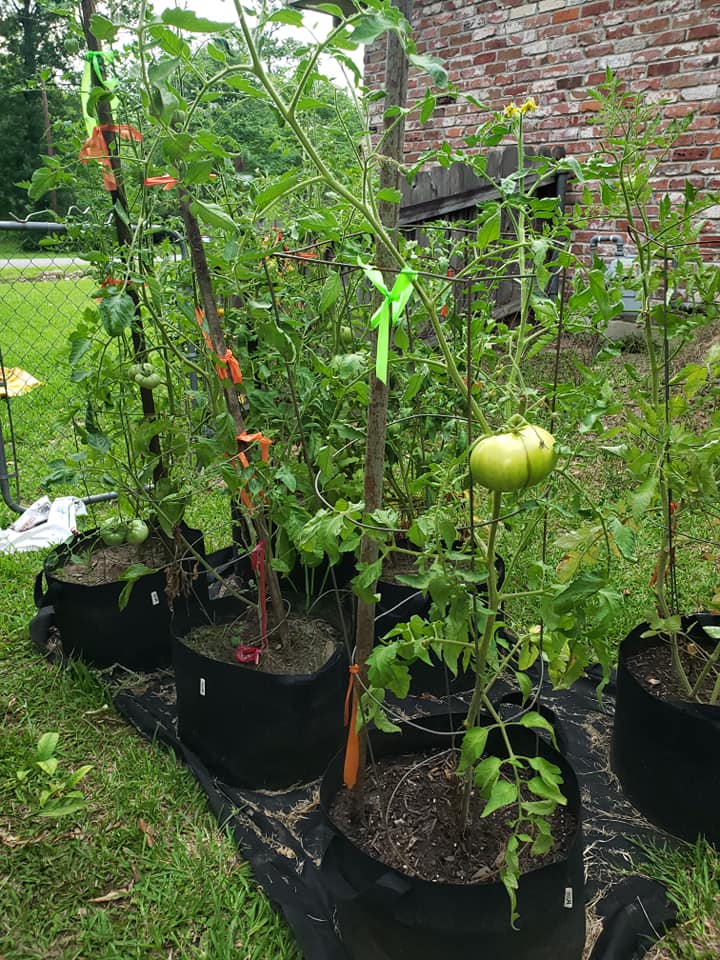
A standout choice, fabric grow bags excel in providing the necessary environment for healthy tomato plants. The breathable fabric promotes airflow and prevents waterlogging, ensuring optimal conditions for growth. Sturdy models with handles offer the added advantage of easy mobility, allowing you to move plants as needed. This type is a top pick for gardeners seeking convenience and effective root aeration.
Fabric grow bags offer an exceptional solution for cultivating thriving tomato plants. Their breathability, water drainage capabilities, mobility features, and support for robust root development make them an optimal choice for both seasoned and novice gardeners.
Plastic Grow Bag
While plastic grow bags are an option, they have notable drawbacks. Their lack of breathability and susceptibility to brittleness in sunlight make them less favorable. The limited ventilation can impede root health and overall plant vitality. Given these limitations, it’s recommended to avoid plastic grow bags to ensure your tomato plants thrive.
Grow bags made from breathable fabric materials provide a more favorable environment that encourages optimal root growth and plant health. By opting for fabric grow bags, you can proactively address the challenges associated with plastic bags and provide your tomato plants with the best conditions for thriving growth and bountiful harvests.
5 Gallon Bucket
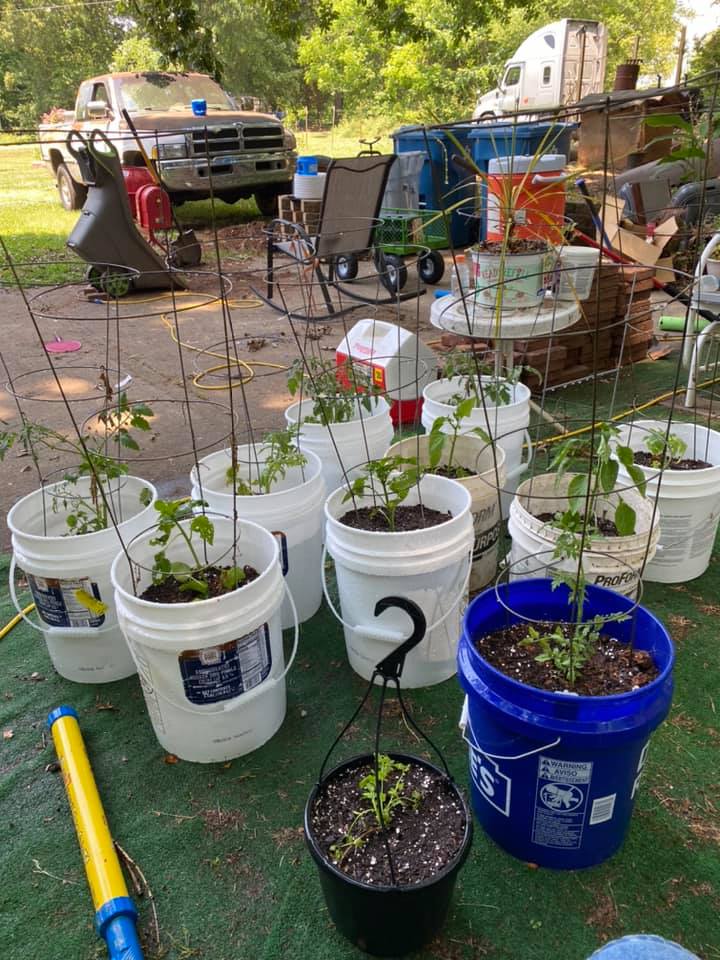
Some gardeners may consider using 5-gallon buckets for growing tomatoes. However, these containers prove inadequate for tomato plants with expansive root systems. The confined space can hinder root development and stunt overall growth, ultimately limiting your harvest potential.
The restricted root space directly affects the overall growth of tomato plants. Insufficient room for root expansion can result in stunted growth above ground as well. The plant’s ability to take up essential nutrients and water becomes compromised, leading to a diminished capacity for photosynthesis, flower production, and fruit development. Ultimately, the constrained environment of a 5-gallon bucket limits the plant’s potential to achieve its full size and yield, thereby limiting the overall harvest potential.
Considering these factors, it’s clear that 5-gallon buckets are not the ideal choice for nurturing thriving and productive tomato plants. While they may work for small-scale or temporary setups, they are inadequate for supporting the extensive root systems and robust growth that tomato plants require to flourish. Gardeners aiming for healthy and high-yielding tomato plants are encouraged to explore alternative options that provide ample space for root development and unrestricted growth.
DIY Tomato Grow Bags
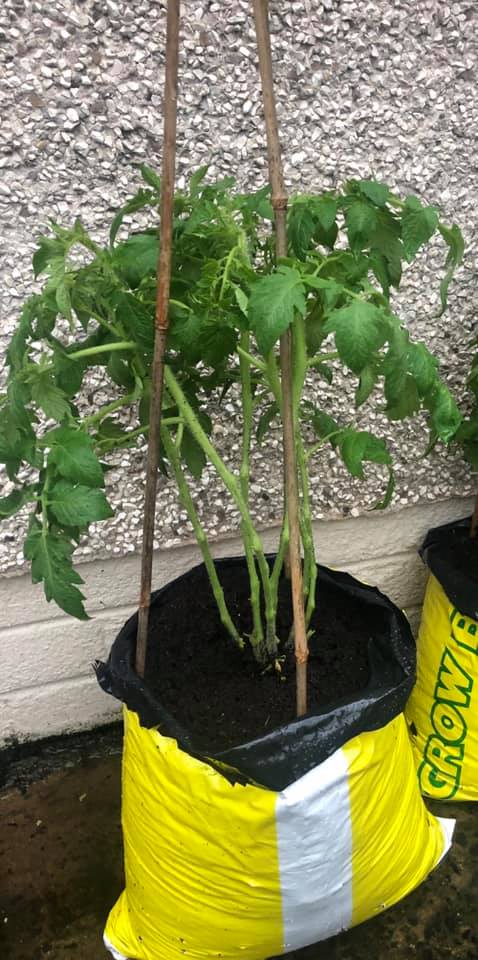
For those seeking creative and budget-friendly solutions, several DIY options are worth exploring. These alternatives include utilizing woven baskets lined with landscaping fabric, repurposing empty feed or birdseed bags, or even repurposing compost bags with a designated growing ring. These DIY approaches provide an opportunity to customize your grow bags based on available materials and gardening preferences.
DIY tomato grow bags offer an avenue for gardeners to exercise creativity and resourcefulness while tending to their tomato plants. These customizable and budget-friendly alternatives, whether utilizing woven baskets, repurposed bags, or growing rings, allow for the cultivation of thriving tomato plants tailored to individual preferences which will not only nurture their plants effectively but also enjoy the satisfaction of crafting unique solutions that cater to their gardening aspiration.
Growing Tomato Plants in Grow Bags: Steps for Successful Planting
Now that you’re familiar with the advantages and types of grow bags, let’s dive into the step-by-step process of growing tomato plants in these versatile containers.
Supplies List:
- Grow Bags
- Potting Mix
- Tomato Seedlings
- Tomato Cages
- Organic Fertilizer
- Organic Compost
- Mulch (optional)
- How-To:
Selecting a Suitable Location
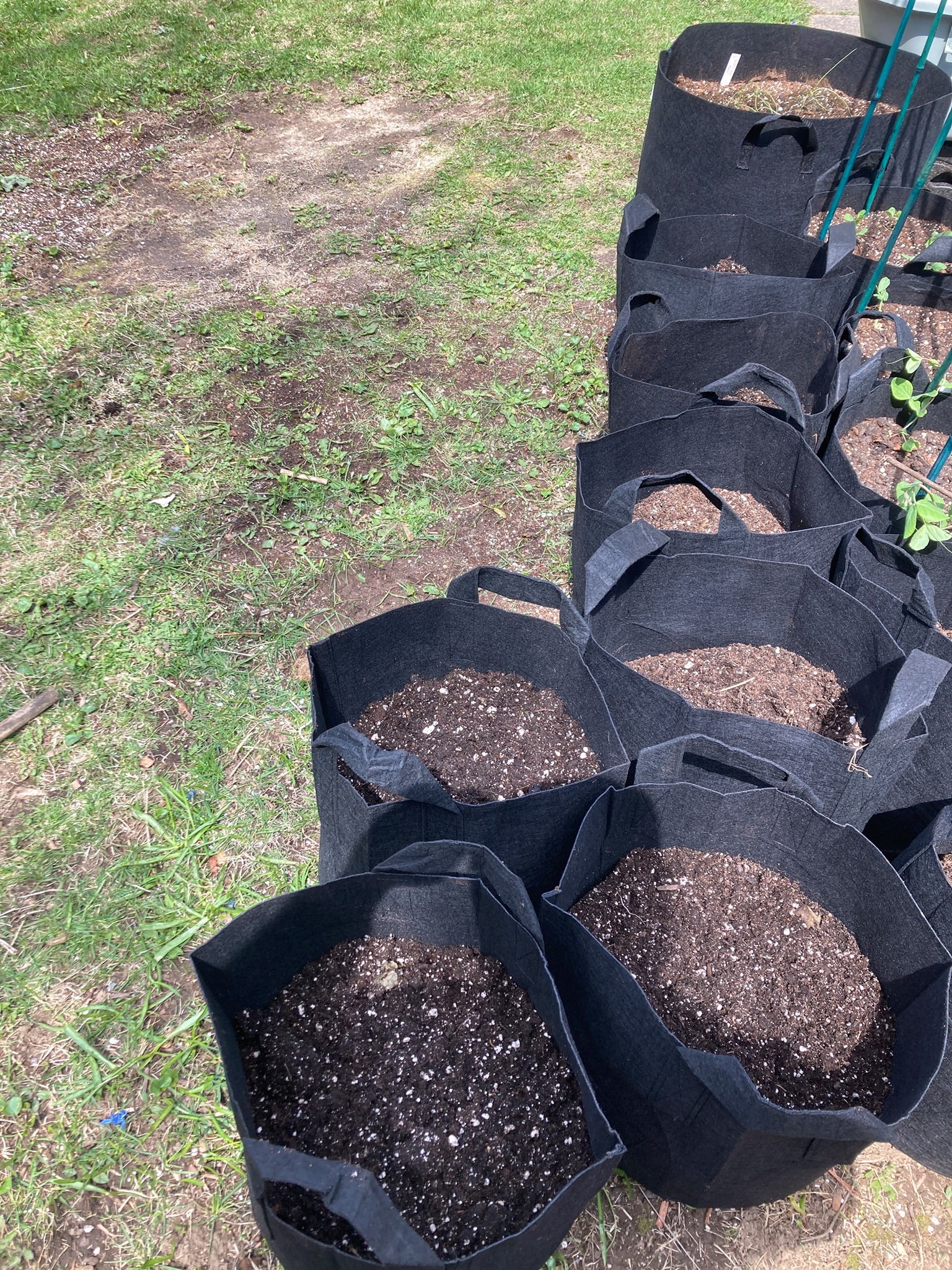
Choose a location that receives a minimum of 8 hours of direct sunlight daily. Tomatoes thrive in sunlight, and this is essential for their growth and fruit production. Placing the grow bags on grass instead of asphalt helps prevent excessive heat buildup, which can stress the plants.
Preparing the Grow Bag
Fill the grow bag halfway with high-quality organic potting mix. This type of soil ensures proper drainage and aeration, promoting healthy root development. Make sure the potting mix is well-moistened before planting.
Pruning the Tomato Seedlings:
Before planting, carefully remove the bottom set of leaves from the tomato seedlings. This encourages the plant to put its energy into producing strong stems and foliage higher up on the plant. It also helps prevent soil-borne diseases from splashing onto the leaves.
Planting the Tomato Seedlings
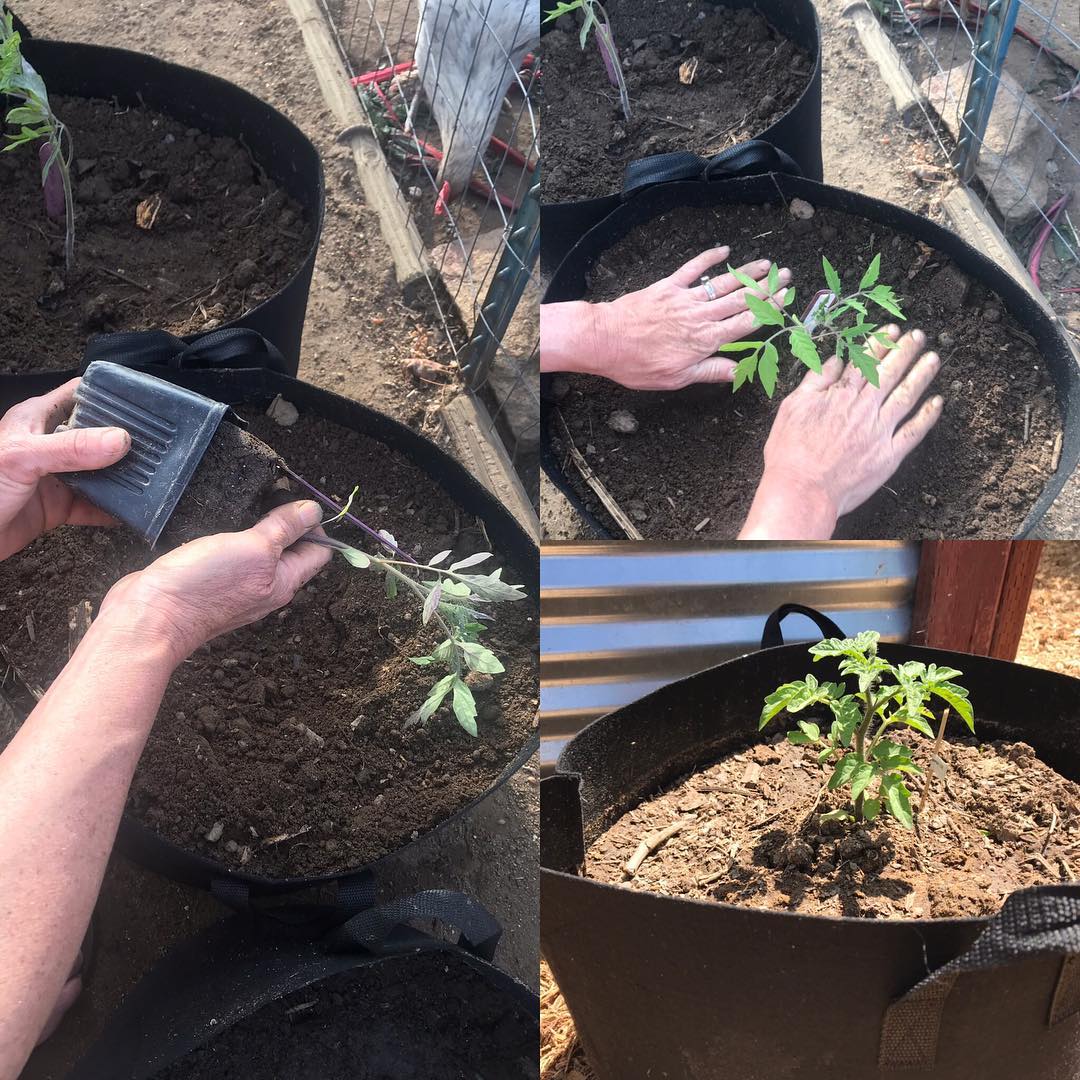
Plant the tomato seedlings in the grow bag, burying them up to the first set of remaining leaves. This encourages the development of additional roots along the buried stem, leading to a stronger and more stable plant. Gently firm the soil around the seedlings to provide support.
Adding Compost
After planting, apply a 1-inch layer of well-rotted compost on top of the soil in the grow bag. Compost is rich in nutrients and organic matter, providing a continuous source of food for the tomatoes as they grow. This will enhance their overall health and productivity.
Securing with Tomato Cages
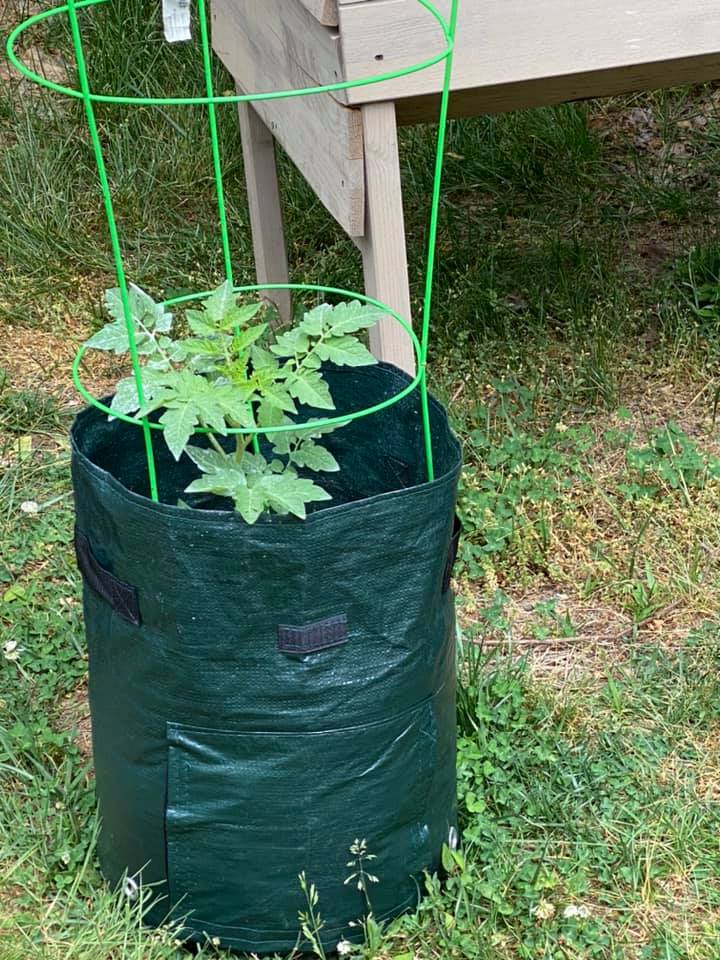
Install suitable tomato cages around each tomato plant. Tomato cages provide support to the plants as they grow taller and start bearing fruit. Ensure that the cages are positioned in a way that they don’t damage the fabric of the grow bag.
Mulching
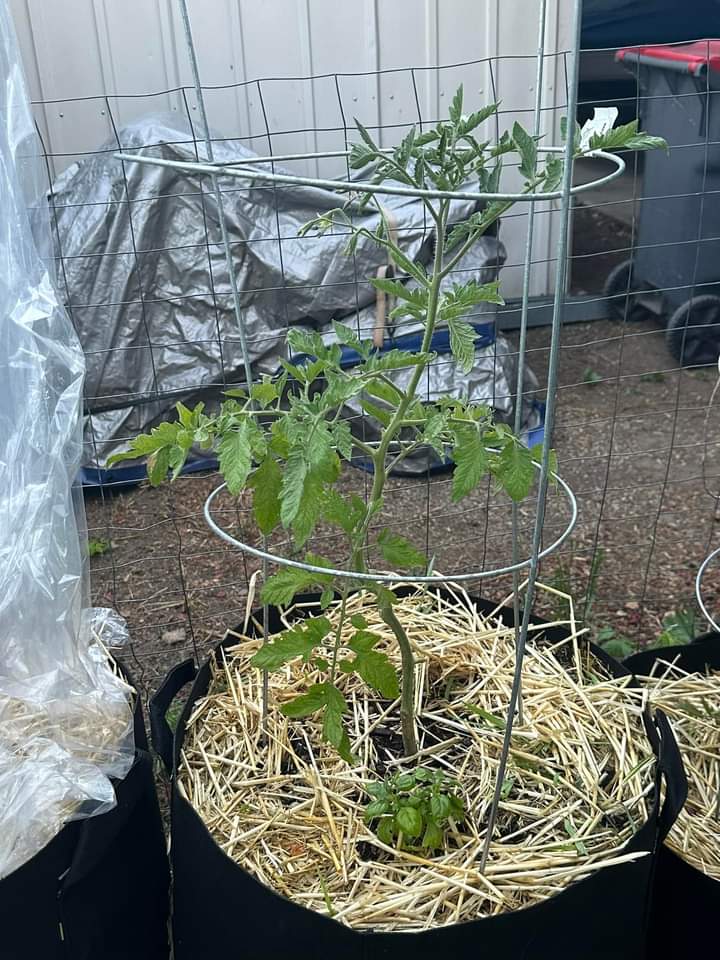
Spread a layer of organic mulch, such as straw, wood chips, or dried leaves, over the surface of the soil in the grow bag. Mulch helps retain moisture, regulate soil temperature, and suppress weed growth. It also acts as a barrier, preventing soil-borne diseases from splashing onto the plants during watering.
Watering
Proper and consistent watering is crucial for tomato plants. Keep the soil evenly moist, but not waterlogged. Water the plants at the base, avoiding wetting the foliage, which can invite diseases. As a general guideline, water when the top inch of soil feels dry to the touch. During hot weather, you might need to water more frequently.
Tips for Successful Tomato Planting in Grow Bags
Choosing the Right Tomato Variety
Tailor your choice of tomato variety to your available space and gardening goals. Determinate varieties are compact and ideal for smaller spaces, as they have a defined growth pattern. Indeterminate varieties, on the other hand, continue growing and producing fruit throughout the season, making them suitable for larger spaces and those seeking extended harvests.
Optimal Sunlight Exposure
Tomatoes thrive in direct sunlight. Position your grow bags in the sunniest spot available, ensuring they receive at least 8 hours of sunlight daily. Adequate sunlight is essential for photosynthesis, flowering, and fruit production.
Strategic Fertilization
Regular feeding is vital for tomato plants’ overall health and productivity. Apply organic fertilizer every 2-3 weeks to replenish essential nutrients. Organic options like fish emulsion provide a balanced nutrient profile that supports robust growth and flavorful fruit development.
Watering Management
The well-draining nature of potting mix in grow bags requires consistent watering. Water the plants daily, keeping the soil evenly moist but not waterlogged. In hot weather, increase watering frequency to prevent dehydration. Stick your finger into the soil to gauge its moisture level before watering.
Disease Prevention Strategies
Guard against soil-borne diseases by practicing effective disease prevention measures. Trim branches that touch the soil to minimize contact with potentially infected soil. When watering, direct the water at the soil level rather than wetting the foliage, which can invite disease development. Applying a layer of organic mulch around the plants further prevents soil splashes onto leaves, reducing disease risk.
Pruning Suckers for Enhanced Fruit Production
Monitor and manage suckers – non-fruiting stems – that emerge between the main stem and leaf crotches. Pruning these suckers redirects the plant’s energy towards fruit production, resulting in larger and more flavorful tomatoes. Regularly remove suckers when they are small to prevent excessive pruning later.
Conclusion
Growing tomato plants in grow bags is a fantastic way to enjoy fresh, homegrown tomatoes, even in the tightest of spaces. With the right choice of grow bags, careful planting techniques, and diligent care, you can cultivate thriving tomato plants that yield a bountiful harvest. Whether you’re a seasoned gardener or a beginner, this comprehensive guide equips you with the knowledge to successfully nurture your tomato plants from seedlings to ripe, juicy tomatoes. Embrace the convenience and rewards of urban gardening by harnessing the potential of grow bags for your tomato cultivation journey.
